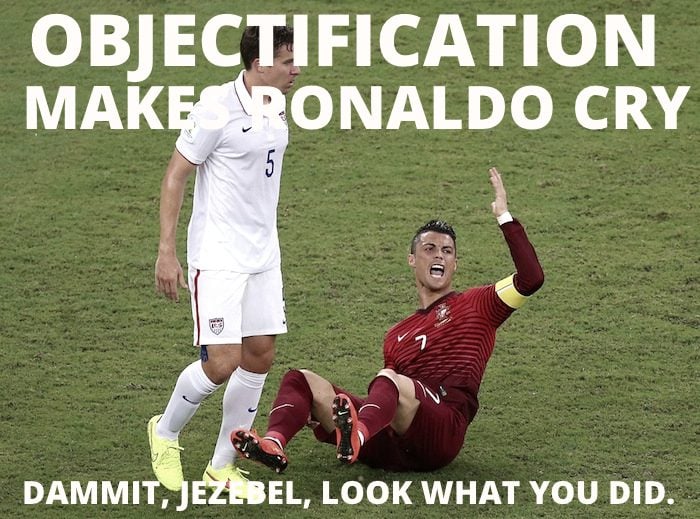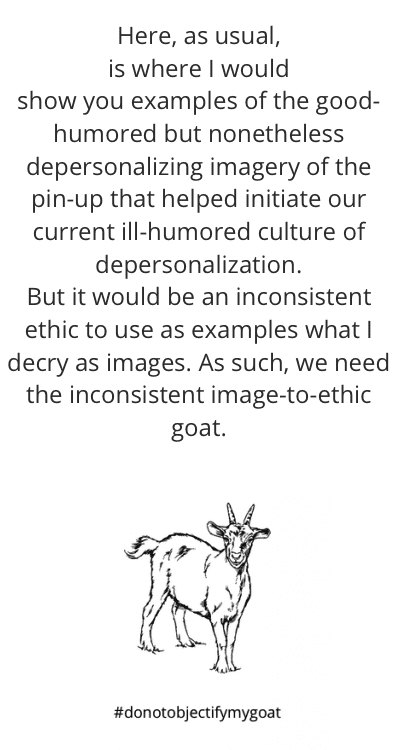
Amanda Hess’ article for Slate, “Why it’s great to objectify World Cup players,” is wonderful. In it, she argues that the hyperbolic and often hilarious “sexual gaze” at soccer players from Jezebel-esque journalists is calling out and offering a counter-balance to the over-sexualization of female athletes.
“These days, clicking through a slideshow of the world’s hottest female soccer players makes you look like a bit of a creep. But admiring the abdominals of male footballers? That just means you have a pulse.” Because “even when Sports Illustrated isn’t putting actual swimsuit models on its cover, it treats female athletes like they’re models, often photographing them in sensual poses and dressing them in revealing clothing instead of snapping them in the action poses typical of male athletes.” But this “new” ogling is…
…a radical re-imagining of a spectacle that’s been controlled by straight male viewers for far too long. When female and gay gazes are applied to the soccer pitch, the results are fun, goofy, and even campy. After every match, Jezebel and BuzzFeed compete to pun faster and harder on sweating and stretching. And Slate’s Simon Doonan has elevated the ogling into an art form. “Brazilian David Luiz is the preeminent pre-Raphaelite beauty of the global soccer scene,” Doonan wrote. And “Can’t you just see Cristiano Ronaldo gobbling down Portuguese grapes whilst flitting across the stage in a revival of L’Après-Midi d’un Faune?”
As with most fiery feminism, she’s right about the problem, wrong about the solution, and funny enough about both that I’m not too concerned with either.
The objectification of women by men is undoubtedly wrong — it’s a particularly vicious insult to the female athlete doing far more amazing things with her body than “looking hot.” Hess argues that the new objectification of male athletes is something qualitatively different than this darker objectification, but forgets, I think, the origin of modern male ogling, at least in its progression through popular media. It did not start with an evil tone, with a leering devaluation of the person — it was engaged in an irony, hyperbole, and a polite campy humor similar to the stuff Hess admires in the female fans of the World Cup.
Pin-up girls came with ironic nursery rhymes printed next to them. They decorated detective stories with hilariously overblown captions — “a goddess shining amongst brutes, but will she escape in time?” The first mainstream displays of soft pornography were stuffed with the same “pre-Raphaelite,” sentimental neo-classicism and hyperbolic romanticism that Simon Doonan drips with in Hess’ previous quote — allusions to Venus, limericks about the goddesses, personified seasons, orientalism, the works.

I’m not arguing that this almost-but-not-quite-tongue-in-cheek objectification will end in the same violent, pornographic objectification of women that the male millions currently consume. It’s unlikely, for the simple reason that men and women are not aroused by visual sexual stimuli in the same way. In general, and according to a 2013 study published in the International Journal of Impotence Research, women are more aroused by mood and images that play a part in an erotic story — men by “directly exposing sexual intercourse and genitalia.” (Not that you need a study to figure that out. There’s a reason 50 Shades of Grey was a female phenomenon. And beyond all the lonely, auto-erotic silliness, I think men are all pretty well aware — as much as we’d like to deny it — that women just ain’t visually slavering after our bodies the way we are after their own.)
So it’s somewhat easier for the “mood” of the objectification Hess promotes to remain “fun, goofy, and even campy.” The female brain doesn’t seem to have the same tendency towards a total explicitness. My worry is that, when you spin this new objectification into a fun, positive corrective to the objectification of women, you open up a brand new theme park of self-justification for every one to play in.

As Hess points out, the phenomenon of objectifying soccer players has already been used to justify the continued objectification of female athletes: “BuzzFeed’s Dorsey Shaw has slyly suggested that his site’s coverage of soccer players’ butts is powerful enough to justify his own editorial obsession with the posteriors of female beach volleyball players.” But what, in the case of the female gaze, can (in general) remain relatively and humorously detached from the actual heat of passion (that sublime and powerful psychological “being taken over” by the visual object) in the male gaze (at least before the decadence of pornography addiction sets in) becomes something serious, something overwhelming — something far more dangerous.
The demise of modern feminism is that it allows men to objectify women in ways the mothers of the movement could never have imagined — while calling themselves feminists. We can post shots of models with books over their genitals with captions that say “intelligence is sexy,” and thereby pat ourselves on the back for respecting women for more than their bodies. We can watch unknown, unnamed, depersonalized women having sex in circumstances and conditions we will never know — so long as its feminist porn. We can perpetuate the institution of sex-slavery — we need only, with the “feminists,” call it sex-work. So too, we will use the feminist embrace of the objectification of male athletes to continue and worsen our own objectification of women — the only difference is that we’ll get to feel like feminists while we do it.
This is why I cannot agree that the only “hangover to this revelry” is that “this obsession over thighs and abs can create the illusion that women and gay men aren’t actually keeping their eye on the ball, and help fuel the stereotype that they don’t constitute “authentic” sports fans.” The real, long-term, deep-stomached, throw-up-the-Advil hangover is the cementing of the idea that the sexes are grappling in a war for individual happiness, in which women give a “we’ll show them” to male sin, slipping on their own self-justified brand of objectification, while men use this same sin as a license for their own joyless, humorless, descent into addiction.
But this is always the outcome of any “war between the sexes” — everyone loses. We are so busy trying to balance the amount of hurt we cause each other, we have forgotten that we need each other. If there is going to be an palatable theory of gender, a workable feminism that doesn’t shoot itself in the foot, surely it must be based on the idea that, if the human person comes in two, it is not because we are in competition, but because we are to help each other rise to the fullness of humanity? Our response to the sin of the other should not be to strike, meeting objectification with objectification (as exciting and powerful as it feels), but rather, to help, to hold accountable, and to work-with — as if men and women are engaged in a mutual project of existence. Of course, this might require an exit from popular media and a return to the family and the neighborhood, wherein we are responsible for each other with a felt and present responsibility — but this is a small price to pay for a little happiness free of resentment.











